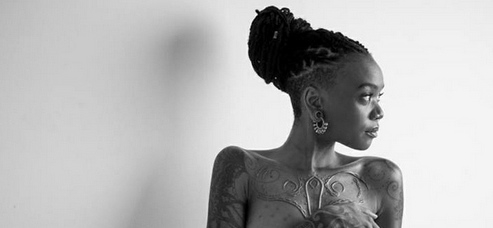Fashion Style: Cosmetics
Area of Influence: Worldwide
Restrictions of Involvement: None
Inventor’s Name: Diwal Sita
Year of Introduction: 200 AV
Still in Fashion: Yes
Scarification is the blemishing/scarring of skin, especially prominent in use amongst devout warriors and hunters, men and women alike. The skin is wounded and left to heal, and new scar tissue forms markings not unlike tattoos. From simple to elaborate, intricate carvings, flowers to claw marks, these scars are supposedly meant to tell a story of their own.
While rumoured to have existed even before the Valterrian, Scarification was initially engaged in only by the Myrians, who saw their battle scars as medals of honour and testament to their prowess. Some used them as a display of how many enemies they've defeated. Diwal Sita formidable warrior with great love for adventure, arrived in Falyndar in the year 200 AV. Despite the hostility and distrust she was shown, found the Myrians to be a marvel and stayed a little longer than most outsiders would usually be willing to. During her stay, Diwal studied and learned of their ways, and noticed that they wore some of the most fearsome decorations ever known. Shorn scalps, bones, teeth - fascinating and morbid displays of their triumphs and battles, accessories rich with history and victories. They were also surprisingly skilled tattooists, and it was their inkwork that initially appealed most to the battle-seasoned Diwal, who sought to acquire one or two of her own to cover the worst of her many scars.
It was on that exact endeavour where Diwal learned to love her body, rather than be ashamed of it. The Myrians saw a veteran, a seasoned fighter whose scars told of her countless battles and the woman's strength. Each was a lesson learned, win or lose, and Diwal was shown how to wear them with pride.
When Diwal left Taloba in continuation of her ventures to the rest of the world, the teachings of Myri's proud tribe were carried with her, close to the warrior woman's heart. Scars began holding more significance, more meaning, and no longer self-conscious, she found herself carving stories into her skin like the tattoo artists of Taloba, only without pigment. For each significant challenge she overcame or each enemy slain, she added a new mark if there wasn't already one, or beautified and enhanced an existing mark. Diwal's reputation as a skilled warrior brought much attention to her wherever she went, and aspiring young men and women alike began adorning themselves in a similar fashion upon seeing the heroine donning intricate scars that seemed to enhance the warrior's allure. The trend picked up eventually, and soon became a form of fashion statement youths and adults alike engaged in, particularly hunters and fighters. Prominently marked areas were often the face, torso and back, where the affectionately termed "Beauty Scars" are proudly displayed on the canvas of skin. Various meanings and symbolisms were derived from the trend with the passing of time, but Diwal's intentions had been for them to represent her own personal conquers and battles. Something to take pride in, rather than be ashamed of.
Generations later, the trend remains a classic. It's not an extremely popular practice, but not quite uncommon either. Nowadays, the meaning is sometimes lost on trend-seeking youths and the ignorant, and is generally considered another form of tattooing.















